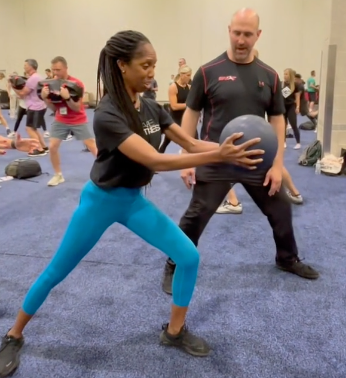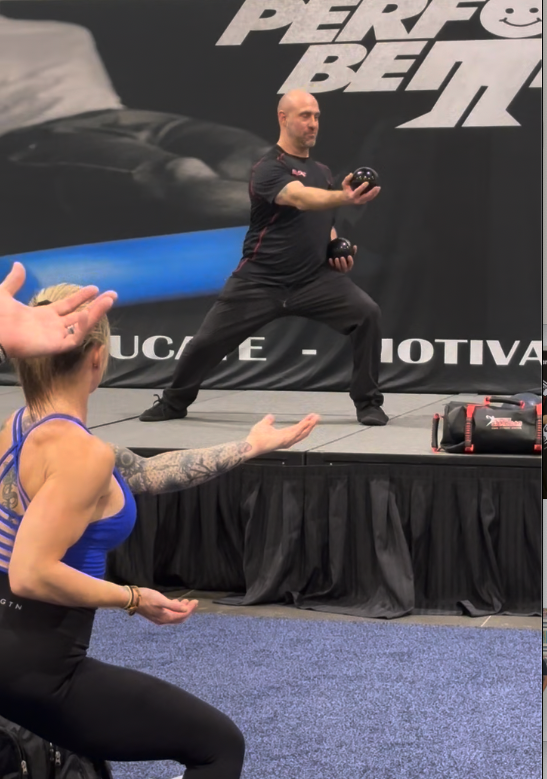A VERY Different Type Of Walking For Greater Fitness & Health
2024-09-7
I actually get really excited when people ask us to do more of a break down of specific exercises and concepts in any of our movement systems. Recently, with people really enjoying and benefitting from our Myofascial Integrated Movement (MIM) system (especially with the release of our Bags, Bells, Balls, & Bands program) there was a question around one technique that came up from several people.

If I told you walking seemed really complicated, that might sound crazy. However, the way we have been teaching how to move laterally as well as forwards (we will get to backwards in later posts) has had a great amount of people asking us to clarify how to do these movements correctly.
Right from the start, I have shared that MIM is based on principles and concepts from yoga, Tai Chi, and qigong. These three classic movements systems have been shown to have SOOOO many health and fitness benefits from reducing chronic pain, anxiety/depression, help insomnia, eating habits, cardiovascular benefits, mobility, and strength. They do so in very different ways that more familiar functional strength training does so they are perfect compliments to one another.
For those that have followed us and what we are sharing with MIM there is more of an emphasis on Tai Chi and qigong than there is yoga. It isn’t because we don’t believe that yoga isn’t immensely valuable, but there are differences in these systems (which is why we use strategies from all three). The most glaring is that especially Tai Chi has more locomotive patterns. This is a BIG reason that Tai Chi has been shown to reduce falls, help knee osteoarthritis, balance, and even lower body strength (1,2,3).

There are additional benefits that help other aspects of our fitness program like foot stability, ankle mobility, lower leg/glute strength and stability, core strength, and aerobic based training. These results can help us in our overall functional strength training and even make them more efficient.
Even compared to brisk walking, these walking movements that we are going to cover also have similar health benefits, better outcomes in lower extremity strength, balance and flexibility, as well as greater cognitive function, and reductions of mortality even compared with jogging (3,4,5,6).
So, there is obviously immense value but how do we learn to do these movements correctly and avoid issues that can arise like knee pain. If people do experience knee pain with any of these movements, it is typically that people lose the technique, over extend themselves, or try to progress too quickly. That is why I have spent time to really dive into how to start learning these movements that can be used as part of your warm-up, in-between exercises, a way to do meditative work either at the end of the workout or just at various times in your day when you need restorative training while also building great physical qualities.
Check it out below….
Save a special 25% on our DVRT Masterclasses that go into depth into these ideas and MUCH more and ALSO get our Better Backs, Knees, & Shoulders program 2.0 and Myofascial Integrated Movement workout plan for FREE! Just use code “online” HERE
References:
Li, J. X., Y. Hong, and K. M. Chan. “Tai chi: physiological characteristics and beneficial effects on health.” British journal of sports medicine 35.3 (2001): 148-156.
You, Yanwei, et al. “Effects of Tai Chi exercise on improving walking function and posture control in elderly patients with knee osteoarthritis: A systematic review and meta-analysis.” Medicine 100.16 (2021): e25655
Lan, Ching, et al. “Tai chi chuan in medicine and health promotion.” Evidence‐Based Complementary and Alternative Medicine 2013.1 (2013): 502131.
Audette, Joseph F., et al. “Tai Chi versus brisk walking in elderly women.” Age and ageing 35.4 (2006): 388-393.
Wang, Na, et al. “Associations of Tai Chi, walking, and jogging with mortality in Chinese men.” American journal of epidemiology 178.5 (2013): 791-796.
Ji, Zhiguang, et al. “The benefits of Tai Chi and brisk walking for cognitive function and fitness in older adults.” PeerJ 5 (2017): e3943.
© 2025 Ultimate Sandbag Training. Site by Jennifer Web Design.







